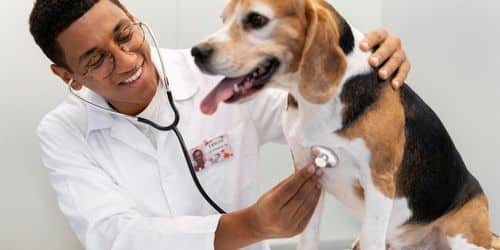A pet is capable of bringing anyone a great deal of delight. But it may come with considerable costs. Pet insurance is a go-to to help cover these unforeseen costs. Good pet medical insurance gives pet owners peace of mind that they can pay for their pets’ care, regardless of the cost or when the incident occurs. So, in this article, we will list the best insurance companies and why you need pet insurance.
What Is Pet Insurance
Pet insurance aids owners in covering the costs of their pet’s medical care. Like health insurance, you pay monthly premiums and deductibles to lower your out-of-pocket expenses when your cat, dog, or other pet needs to visit the veterinarian due to an injury or disease.
Since you never know whether or when your pet will need to see a veterinarian, pet insurance providers offer coverage for wellness checkups, accidents, and illnesses so you can afford the proper medical care for your animals. Nationwide provides all these plan specifics and more, making it the finest pet insurance provider.
Why Pet Insurance Is Necessary
In a 2022 research, 38% and 45% of cat and dog owners, respectively, said they were not financially prepared for pet expenses despite believing they were. So the question is, would you be willing to spend anywhere between a few hundred and a few thousand dollars? Pet insurance can be a vital safety measure if not.
There is no obligation to purchase pet insurance when you get a pet, and there are no consequences if you choose not to. You should purchase it to ensure you never have to worry about an unforeseen pet medical expenditure. Although insurance may be an extra cost, it might save you hundreds or thousands of dollars throughout your pet’s life.
How are the Prices for Pet Insurance Determined
#1. Age
Younger animals, less likely to experience health problems, are far less expensive to insure. In addition, it costs more to treat elderly pets. Additionally, the costs for most pet insurance will increase as your pet gets older.
#2. Species
Whether you are insuring a dog, cat, horse, or an exotic pet, prices will vary based on the species. Because cats often have fewer health difficulties than dogs, cats are typically less expensive to insure.
#3. Breed
Breeds vary in their sensitivity to health issues, affecting how much insurance will cost. For instance, labrador and golden retrievers are more likely to develop hip dysplasia, and bulldogs and other short-nosed breeds are more likely to experience breathing difficulty, dental disease, and other health concerns.
#4. Your Residence
Your residence has an impact on your premiums. Also, your premiums will be more expensive if living expenses and veterinary costs are greater where you live.
#5. Type of Plan
The price of your pet’s insurance depends on the type of plan. Plans for accidents only typically cost less than plans for accidents and illnesses.
#6. Rates of Reimbursement and Deductibles
Your premiums will depend on the deductible and reimbursement percentage of the plan you select. Your premiums will increase because your insurance will start paying off sooner if you have a low deductible. Also, your premiums will be reduced, but you’ll also have to pay more upfront before your insurance pays a claim if your deductible is large. The exact opposite is true if your deductible is low. Your rates will remain lower if you select a low reimbursement rate, while premiums will increase if you select a high one.
#7. Benefit Caps
Policies with larger benefit caps or unrestricted coverage are typically more expensive than those with smaller ones.
How to Choose Your Pet’s Insurance Provider
#1. Research the Various Coverage Possibilities
Accidents, illnesses, inherited and congenital disorders, chronic conditions, behavioural issues, prescription drugs, hospitalisations for surgery, and diagnostic tests are a few of them. It’s crucial to be aware of the particular health risks associated with your breed and search for a plan that covers those your pet may be more prone to suffer throughout its lifespan.
#2. Ensure You are Familiar with the Restrictions and Exclusions that Apply to a Policy’s Use
Pre-existing conditions, breed-specific exclusions, age restrictions, waiting periods, maximum benefit levels, and deductibles and copayments should all be clearly stated. Some of these things affect insurance costs, and accessibility is important. Examine the premium cost, the deductibles, the annual caps, and any discounts offered (such as those for enrolling several pets or purchasing multiple policies).
#3. The Availability of Customer Service Representatives
The availability of customer service representatives, business hours, contact options (phone, email, chat), the window of time for submitting a claim, the manner of filing, the typical turnaround time for claim reimbursement, and the capability to track claims online are all important factors to consider. The American Animal Hospital Association’s chosen business supplier for pet insurance, Pawlicy Advisor, offers a comparison tool that enables you to assess the best insurance company plans while considering the requirements specific to your pet’s breed, area, and age.
How to Evaluate Pet Insurance Companies
Pet insurance companies offer various options regarding coverage, cost, and exclusions. When contrasting businesses, take into account the following:
Premiums vary significantly from company to company and are based on your region and the age and breed of your pet. Obtaining a few sample pet insurance quotes from several companies, like those on our list above, is the greatest method to compare premiums.
#2. Coverage
Coverage limits might be annual, per condition, or per event, depending on the company. Limits on annual coverage have a single deductible that is reset each year. Each ailment has its deductible with per-condition coverage, but you only need to pay it once throughout the pet’s lifespan. In addition, you can easily exceed the condition’s maximum duration for your pet. With pre-event coverage, the deductible is the same for each occurrence and resets with each new one.
#3. Deductible
The deductible is the portion of the cost you are responsible for paying before your insurance company will pay claims. Your premium will be higher the lower the deductible.
#4. Reimbursement Percentage
The reimbursement percentage determines the amount your insurer will pay once your deductible is met. For instance, if your insurance company grants a 70% reimbursement on a $1,000 payment, you are still liable for $300 of the cost.
#5. Treatments that are Covered and Those that are not
As previously mentioned, insurance companies have various policy exclusions. Spend time learning about such exclusions to avoid being stuck with a hefty, unforeseen payment.
Best Pet Insurance Companies
#1. Figo
- Best for complete protection
- Accident, illness, and wellness coverage
- Starting price: $37 for dogs; $28 for cats per month.
- Maximum coverage per year: $5,000 to infinity
- $100 to $750 in deductions
- Covered pets: dogs and cats
Our choice for the most complete pet insurance option is Figo. With $5,000, $10,000, or limitless yearly benefits, it provides best-in-class 100% reimbursement for covered expenses (along with 70% to 100% reimbursement). Preexisting conditions, preventative dental care, elective treatments, and regular wellness are not covered unless you buy a separate rider, much like with other carriers.
You can design your unique plan to include veterinary exam costs and other wellness care coverage. Additionally, Figo provides an additional care pack that includes coverage for pet boarding costs, pet emergency vacation cancellation, pet theft or loss, liability for third-party property damage up to $10,000 per policy, and cremation or burial costs.
As with most conventional pet insurance plans, you must pay your veterinarian’s fees in full before submitting a claim for reimbursement online, via the Figo Pet Cloud mobile app, by fax, or by emailing or faxing your paid invoice. Payments are made within 10 business days via check addressed to the recipient or within 5 business days by direct deposit. Using the Figo Pet Cloud app, you can interact with other pet owners in your region and keep your pet’s medical records online.
#2. Nationwide
- Preferred for exotic pets
- Accident, illness, and wellness coverage
- Starting price: $34 for medical insurance and $64 for monthly full coverage.
- Maximum coverage per year: $10,000, to be determined by condition
- $250 in deductibles
- Covered animals include dogs, cats, birds, and unusual pets.
Our research shows that Nationwide is the only business that provides reimbursement pet insurance coverage for exotic and bird pets. You must contact Nationwide directly to obtain prices for your exotic animals, but you may buy dog or cat insurance online. The comprehensive wellness programs offered by Nationwide include yearly physicals, immunizations, blood tests, urinalyses, and flea and heartworm preventatives.
Unlike most pet insurance policies, each plan has a $250 yearly deductible, 90% reimbursement, and specified annual benefits for each disease. The yearly benefit ceiling for the entire pet plan is $10,000, and pet owners can select a reimbursement level of 50%, 70%, or 90%. Additionally, Nationwide provides complete pet coverage, which covers congenital ailments. Pet owners can call a 24-hour vet customer service line for guidance and prompt assistance.
#3. Pet Best
- Best for inexpensive, basic protection
- Type of Coverage: Accident, illness, and preventive care
- Initial cost: $9 per month for dogs and $6 per month for cats
- Maximum coverage per year: $5,000 to infinity
- $50 to $1,000 in deductions
- Covered pets: dogs and cats
We suggest Pets Best since they have the lowest monthly premiums and a wide selection of insurance covering accidents and illnesses. This insurance company provides pet owners with reasonably priced insurance coverage. To make sure you choose the appropriate level of coverage, it can be tedious to filter through all the conditions included and excluded in its three levels of insurance.
A rare find in the pet insurance market, Pets Best offers plans that cover routine vet visits and the cost of vaccines, spay/neuter procedures, bloodwork, and heartworm preventatives for an extra $16 to $26 per month.
Pets Best is a reimbursement insurance program like Figo. You can submit a claim by taking a picture of your paid invoice, uploading it via the mobile app or online website, responding to a few questions, and then submitting it for reimbursement. You can also file by sending their claims form and a copy of your paid, itemized vet invoice through email, fax, or postal service. According to Pets Best, you can anticipate receiving your money back by direct deposit in as little as two days or via paper check between five and seven.
#4. Pet Assure
- Best for pets with pre-existing conditions is
- Discount plan: kind of coverage
- Beginning price: $10 per month
- Unlimited maximum annual coverage
- No deductibles
- Dogs, cats, birds, exotic animals, agricultural animals, and tiny animals are covered pets.
In contrast to most pet insurance programs, Pet Assure is more of a discount program that provides 25% off all in-house medical care at participating veterinarians without the need for claims. We like that this plan provides savings for preexisting problems that aren’t covered by most insurance, provided your veterinarian recognizes Pet Assure, which you should confirm before applying.
There aren’t any waiting periods, deductibles, or annual maximums with Pet Assure. Its discount program has a few exclusions, including those for non-medical services, external lab work or other services, food, and prescription drugs.
Plans for one small or large pet (depending on weight) or a multi-pet plan, which covers up to four animals of any size, are available with Pet Assure. The unlimited plan covers five or more animals. Discounts are taken off at participating veterinarians when you pay your vet bill.
#5. Embrace
- Best in times of need
- Type of Coverage: Accident and Illness
- Starting prices are $38 per month for dogs and $24 for cats.
- Maximum yearly protection: $5,000–$30,000
- $200 to $1,000 in deductions
- Covered pets: dogs and cats
Embrace may offer the best coverage for emergency visits, veterinary specialists, and hospitalisation charges if your pet is prone to injuries. Almost everything is covered by Embrace except preexisting conditions. In its Healthy Pet program, for each year you go without receiving a claim reimbursement, your deductible is reduced by $50. Your deductible resets to the initial amount when a claim is made.
#6. Pumpkin
- Best for routine veterinary visits
- Accident, illness, and wellness coverage
- Starting price: $31 monthly for cats and $72 for dogs.
- Maximum yearly protection: $20,000
- $100 to $500 in deductions
- Covered pets: dogs and cats
Pumpkin, a newcomer to the pet insurance market, offers comprehensive coverage that can reimburse you for various ailments that other pet insurance providers won’t cover, including parasite infections, behavioural problems, dental disease, and hereditary illnesses. However, in return, your monthly premiums will be greater. However, if you frequently see the veterinarian, this insurance offers a larger yearly maximum coverage than most.
With an option of a $100, $250, or $500 annual deductible, Pumpkin also provides 90% reimbursement coverage for canines and felines. A smaller deductible will result in a higher monthly cost. To fully cover the costs of qualified wellness exam fees, vaccinations, and faecal tests, you can also add $12 to $19 to your monthly plan.
Must You Purchase Pet Insurance?
If you’re unsure if you should purchase pet insurance, consider your budget and your pet’s needs. For instance:
#1. If Your Pet is Elderly or Suffers from a Chronic Illness
Health and accident insurance coverage can be too expensive and not provide for the care of your pet. Discount plans might be more valuable because they don’t exclude older animals or people with health issues.
#2. If You Want Affordable Coverage
An accident-only plan can be suitable if you want the least expensive coverage while still having some protection in an emergency. Accident-only insurance covers treatments for sudden injuries like shattered bones or bite wounds and is available for a few bucks per month.
#3. If Your Pet Is Still Young
Pets that are young, healthy, and haven’t displayed any symptoms of health problems are inexpensive to insure. Securing coverage when your pet is young can protect you against future accidents and illnesses.
#4. If Your Pet Requires Surgery or Chemotherapy
Unfortunately, pet insurance won’t help if your pet already needs treatment due to an injury or illness. There may be a waiting time before coverage kicks in, and any problems that existed before you enrolled in the insurance will not be covered.
What Drawbacks Exist for Pet Insurance
Pet insurance has many restrictions you should be aware of, yet it can be useful in safeguarding animals.
- Conditions from the Past are Not Covered
- No insurance provider will pay for these. Premiums could go up. This is because many older Pets have greater health problems. There are frequent restrictions to coverage: There are annual or lifetime time limits on how long insurance will cover your pet.
- Typically, you must pay in advance: A few pet insurance providers will pay your veterinarian directly, but most won’t. You will first be responsible for payment before being reimbursed. It Might be pricey: Many pet owners spend more on insurance than they save. It’s about safeguarding your finances if your pet is unlucky enough to require future pricey medical care.
Can I Get Pet Insurance for Multiple Pets?
You will have one policy for all your qualifying pets when you get pet insurance for multiple pets, or you will have individual policies for each. Even though your pets are covered under the same policy, you may choose a different yearly deductible and reimbursement sum for each.
How Many Pets Can You Have on Insurance?
Although most insurers may insist that you purchase separate plans for each pet, some will let you add numerous pets to a single policy. You should be aware that many pet insurance providers only cover cats and dogs, so animals like birds, hamsters, snakes, and rabbits may not be covered.
Conclusion
You need to be sure that your pet insurance provider will be around for the long run and can handle your claims efficiently while looking for coverage. Our preferred choice is Nationwide because it has a proven track record of offering pet insurance and honouring claims and because current Nationwide customers can save 5% on rates by adding pet insurance to their policies.






